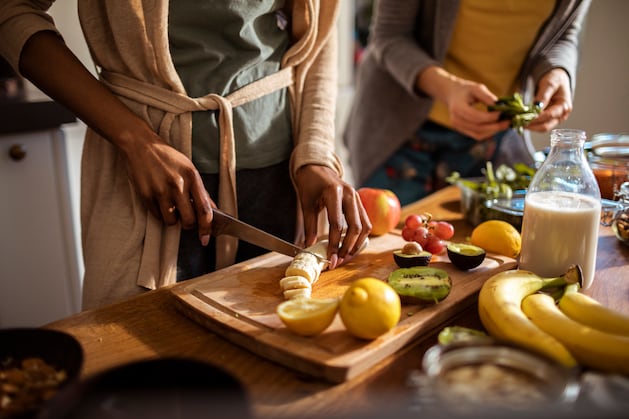Wrong and unhealthy nutrition puts strain on the kidneys. Then it’s time to give the filter organs a week to regenerate. What you should pay particular attention to.
When it comes to detoxification and relief, many people think of the liver first. That’s certainly true. However, what is often overlooked is that our kidneys also do an amazing job of removing pollutants and are vital to life. They clean over 1000 liters of blood per day using tiny filters called nephrons.
They filter out urea, phosphates, toxins and residues from medications, form urine and flush the pollutants out of the body. However, the filter organs of around eight million Germans are constantly overloaded and their kidney function is already impaired. The main reason is our lifestyle with poor nutrition, the resulting obesity, high blood pressure and diabetes.
It is primarily fast food, lots of fat and sugar that can put a strain on our kidneys. The ingredients that are particularly important are:
Table salt: The kidneys have to wash out excess salt from the blood. Too much salt in the food, i.e. more than the daily recommendation of six grams, overwhelms the filter organs. A lot of salt is contained in fast food and ready meals, but also sausage and cheese.
Phosphate: The mineral serves as a stabilizer and thickener and is added to many foods under the E numbers 338 to 341, 343, 459 to 325. Sausage in particular, but also cola and processed cheese contain phosphate. It puts strain on the kidneys and supports the calcification of the vessels.
Protein of animal origin, especially meat: If kidney function is already somewhat limited, too much protein can put additional strain on it. The guideline is: no more than 1.5 grams of protein per kilogram of body weight; more could put strain on the kidneys.
Purines: Offal, meat and sausage contain, among other things, purines that are metabolized in the body to form uric acid. The kidneys have to filter out uric acid and excrete it in the urine. However, the kidneys cannot cope with an excess of uric acid. The uric acid crystallizes; these crystals can collect in the kidneys and form kidney stones. By the way, an increased uric acid level and too much animal protein are, among other things, responsible for an imbalance of acids and bases in the body. Acidification occurs and this also puts strain on the kidneys.
Foods that contain a lot of these substances should therefore at least be reduced during the 7-day kidney detoxification. The ten most important rules:
Morning: herbal tea to taste, wholemeal bread with low-fat quark, seasoned with freshly ground caraway, paprika, turmeric
Lunch: Pasta and carrot pan with spring onions and pine nuts. To do this, cook the wholemeal ribbon pasta until soft, sauté the carrots and onions in a little safflower oil during the cooking time, and finally roast the pine nuts and add them. Mix everything on a large plate, season with fresh herbs, such as parsley, and add a few dabs of ricotta on top.
Evening: oven-baked vegetables. To do this, wash sweet potatoes, peppers, onions, garlic, potatoes, eggplant (choose according to your taste), cut into strips and place on a tray greased with olive oil, bake at 200 degrees, season with fresh herbs, such as rosemary. If that’s too dry for you: season low-fat yogurt with garlic and fresh dill and use as a dip.
In between meals/snack: Fruit, whole grain pastries, such as sesame pretzels, without salt sprinkles, green vegetable smoothie, such as with kohlrabi and cucumber, water, juice of a freshly squeezed lemon, diluted with tap water
Morning: Muesli made from oatmeal, some flaxseed, berries and low-fat yogurt, herbal tea
Lunch: Pasta salad with dried tomatoes and oranges. To do this, cook pasta such as farfalle or penne until al dente, chop dried tomatoes and fillet an orange. Dress the tomato strips and orange fillets with a little olive oil, chop fresh parsley or chervil and season the dressing with it, add fine fruit vinegar to taste, mix with the pasta.
Evening: Tomatoes and cucumbers with mozzarella, flavored with high-quality olive oil and fresh basil, with whole grain bread
In between meals/snack: Fruit, whole grain pastries, such as sesame pretzels, without salt sprinkles, orange-red smoothie, such as with berries, orange and carrot, water, juice of a freshly squeezed lemon, diluted with tap water
Morning: Wholemeal bread with cream cheese made from goat or sheep’s milk, seasoned with fresh herbs to taste, such as chives
Lunch: chicken steak with pepper vegetables (red, yellow and green peppers, onion, a little sour cream) and rice
Evening: apple crumble. To do this, peel tart apples, cut them into slices and place them in a lightly buttered baking dish. Drizzle with the juice of a lemon. Knead a crumbly mixture from 100 grams of wholemeal flour, a handful of oat flakes, 80 grams of brown sugar and the same amount of butter, a pinch of cinnamon and sprinkle it over the apples, bake it in the oven at 200 degrees.
In between meals/snack: Fruit, whole grain pastries, such as sesame pretzels, without salt sprinkles, green vegetable smoothie, such as with banana, cucumber, green salad, rice milk, juice of a freshly squeezed lemon, diluted with tap water
Morning: Muesli with seasonal berries or apples, buckwheat flakes, oat milk
Lunch: Italian bread salad. To do this, cut the ciabatta into slices, divide it into bite-sized cubes, rub it with a sliced garlic clove and drizzle with a little olive oil, then roast it briefly on a baking tray in the oven. Meanwhile, chop the tomatoes, cucumber and onions for the salad and place in a large bowl. Prepare vinaigrette from olive oil, balsamic vinegar and many fresh herbs to taste, mix with the vegetables. Let the bread cool briefly, fold it into the salad and enjoy.
Evening: vegetable soup (minestrone). Prepare vegetable stock from vegetables to your taste – beans, zucchini, carrots, fennel, celery – first sauté the vegetables briefly in olive oil, then top up with a little water. Season with bay leaf, basil and a pinch of salt (no more). Just before cooking, stir in a handful of soup noodles.
In between meals/snack: Fruit, whole grain pastries, such as sesame pretzels, without salt sprinkles, red smoothie, such as with seasonal berries and bananas, water, juice of a freshly squeezed lemon, diluted with tap water
Morning: Scrambled eggs from two eggs, pour over a diced tomato, season with fresh herbs, and serve with wholemeal bread
Lunch: Risotto with radicchio. To do this, sauté risotto rice in olive oil, add a finely diced onion and garlic clove, fry briefly, pour in a little vegetable stock and cook over low heat. In another pan, sauté the sliced radicchio in olive oil, add a little salt, add a dash of oat cream and add this vegetable mixture to the risotto, folding in lightly. Season with fresh rosemary.
Evening: Baked vegetable stew. To do this, place chopped vegetables of your choice in an ovenproof casserole dish with a lid, such as beans, pumpkin, tomatoes, zucchini, peppers, onions, kohlrabi. Add a cup of water, season with a little salt but lots of herbs, and a little chili to taste, cover and cook at 180 degrees for about 30 minutes. Then add ricotta flakes over the casserole and enjoy with wholemeal baguette.
In between/snack: Fruit, whole grain pastries, such as sesame pretzels, without salt sprinkles, green smoothie, such as with lettuce, pineapple, cucumber and water, juice from a freshly squeezed lemon, diluted with tap water
Morning: Muesli made from millet, seasonal fruit and rice milk
Lunch: salmon pasta with lemon and zucchini. To do this, sauté salmon and chopped zucchini in a little olive oil, add a little sour cream, season with fresh lemon juice and a little salt. Cook the pasta and mix the two together and grind the pepper over it.
In the evening: Sauté fried aubergines, along with eggplant slices and onion slices, in a little olive oil, flavor with lemon, add cherry tomatoes and capers to taste. Serve with rice or whole grain baguette.
In between meals/snack: Fruit, whole grain pastries, such as sesame pretzels, without salt sprinkles, green vegetable smoothie, such as with romaine lettuce, apple and water, juice of a freshly squeezed lemon, diluted with tap water
Morning: Wholemeal bread with herb cream cheese
Lunch: Gnocchi with tomatoes. Make your own gnocchi from 500 grams of floury, boiled potatoes, press or mash them through a sieve, knead with 125 grams of flour and an egg, season with a pinch of salt and nutmeg. Form the potato dough into rolls, cut off small slices, press a fork onto each piece and place in boiling water. When the gnocchi float, they are done. Simply drizzle with a little melted butter and flavor with fresh sage, or serve with a simple tomato sauce (fresh tomatoes, onion, garlic, pinch of salt, teaspoon of honey). Gnocchi freeze well, so simply make double the quantity and store it in the freezer.
In the evening: Asparagus with green vinaigrette, peel green or white asparagus, cook, drain, prepare vinaigrette with olive oil, balsamic vinegar and fresh herbs as desired. Plus whole grain baguette.
In between/snack: Fruit, whole grain pastries, such as sesame pretzels, without salt sprinkles, red smoothie, such as with beetroot (cooked), apple, water, juice of a freshly squeezed lemon, diluted with tap water
The kidney detox week can be used as an introduction to a kidney-healthier diet. Because one thing is clear: Anyone who then immediately stuffs themselves with fast food and consumes a lot of meat, sausage, fat, salt and sugar will quickly ruin their success and damage their kidneys.
And the permanent one is not as strict as our nutrition plan for a week, it is actually quite simple: Make water your favorite drink, cook for yourself more often, eat meat only once a week and fish once, feast on fruit and vegetables, pay attention to fiber, but go easy on salt!
This is easier than you thought. During our low-salt week, most people’s tastes have probably already changed so that salt is perceived much more intensively, so less salt will be needed for seasoning in the future. The same applies to sugar.
By the way, this diet is not only good for the kidneys: it can reduce the risk of high blood pressure and diabetes. Both diseases put particular strain on the kidneys, which closes the circle again.









